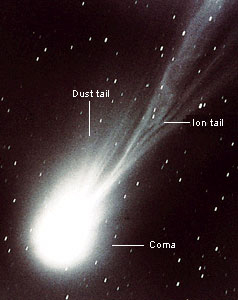Comet Threat More Constant Than Thought

It certainly captures the imagination: a star passing silently by our solar system knocks a deadly barrage of comets towards Earth. However, recent simulations by one group of researchers has shown that these star-induced comet showers may not be as dramatic as once thought.
The idea of nearby stars influencing comets goes back to 1950, when the astronomer Jan Hendrik Oort hypothesized an invisible repository of comets — the so-called Oort cloud — swarming around the solar system out to a distance of 100,000 AU (one AU is the distance between the sun and the Earth).
Oort assumed that stars passing through the cloud would cause a fresh batch of comets to fall in towards the sun, where they become visible to astronomers. Such a disturbance could have long-term effects.
"The comets we see now could be from a stellar passage hundreds of millions of years ago," said Hans Rickman of the Uppsala Astronomical Observatory in Sweden.
However, Rickman and his colleagues have confirmed that star encounters alone cannot explain comet behavior. Using a computer model of the Oort cloud, they show that gravity effects from the galaxy are equally important. The results are reported in a recent article in the journal Celestial Mechanics and Dynamical Astronomy.
Two stars passing in the night
Although Earth has almost certainly been hit by comets throughout its history, it is not all that clear how often that has happened. Much of the crater history on Earth has been erased because of erosion or tectonic activity.? The remaining craters could have come from asteroids instead of comets.
Get the Space.com Newsletter
Breaking space news, the latest updates on rocket launches, skywatching events and more!
"It's quite difficult to tell a comet-induced crater from an asteroid one, since the impactor gets essentially vaporized," Rickman said.
Comet impacts are, however, likely to be more energetic (and therefore more damaging), since comets are moving much faster than asteroids when they pass by Earth.
Comet orbits can be altered whenever another star comes within 10,000 AU of our sun. Such a close encounter — occurring every 100 million years or so — will not typically disturb asteroids or planets, but it definitely "shakes up the whole Oort cloud," Rickman said.
Most scientists have presumed that these star crossings will lead to a shower of comets raining down on the Earth and the rest of the inner solar system. Some have even claimed to find evidence of periodic mass extinctions that might be explained by a single (as-yet-unidentified) star in an elliptical orbit around the sun.
To study the effect of stellar perturbations, Rickman and his colleagues model the Oort cloud with a sample of one million comets (the true number of cloud comets is unknown, but certainly much higher). The simulations are allowed to run for a time period corresponding to the 5-billion-year age of the solar system.
The results show that stars can induce comet showers, but the contrast with non-shower periods is less than what people have thought before, Rickman said. This leveling out in comet activity is due to the influence of the gravitational field of the Milky Way.
Galactic tide
Astronomers have known for some time that our galaxy's gravity has an influence on the Oort cloud. Specifically, the cloud experiences a tidal effect due to the fact that the gravitational field is stronger the closer one is to the plane of the galaxy.
The simulations by Rickman and colleagues show how the galactic tide constantly gives a small nudge to the cloud's comets. Some of these comets are in rather unstable orbits to begin with, so the slight push can send them on a sun-bound trajectory. Eventually, however, all these unstable comets are ejected from the solar system.
And this is where stellar encounters become important. They scramble the Oort cloud, so that the galactic tide has a new crop of unstable comets to funnel into the inner solar system.
"The general picture spawned by our results is that injection of comets from the Oort Cloud is essentially to be seen as a teamwork involving both tides and stars," the scientists write in their paper.
This star-tide collaboration keeps a relatively steady supply of comets zooming nearby, so the threat from comet impacts probably does not change much over time.
- Video - Comets: Bright Tails, Black Hearts
- Strange New Comet Explains Old Mystery
- All About Comets
Join our Space Forums to keep talking space on the latest missions, night sky and more! And if you have a news tip, correction or comment, let us know at: community@space.com.

Michael Schirber is a freelance writer based in Lyons, France who began writing for Space.com and Live Science in 2004 . He's covered a wide range of topics for Space.com and Live Science, from the origin of life to the physics of NASCAR driving. He also authored a long series of articles about environmental technology. Michael earned a Ph.D. in astrophysics from Ohio State University while studying quasars and the ultraviolet background. Over the years, Michael has also written for Science, Physics World, and New Scientist, most recently as a corresponding editor for Physics.












